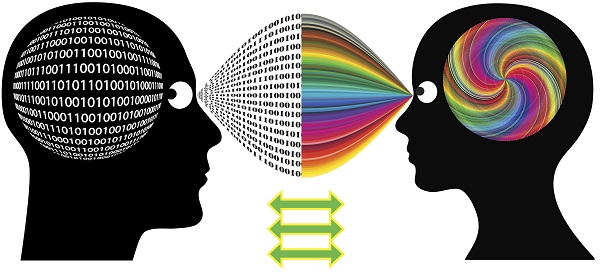10 Jan Shades of Meaning
I have been sharing my observations on the electrical behavior of the brain this month, with a brief glance at perspectives on perception. My work began, and may end with language. As my springboard into artificial intelligence, I’ve been trying for years to develop computer programs that can understand your intent and use that understanding to better answer your questions, engage you in intelligent dialog and accurately translate what you said into other languages. Allow me a word on language complexity today.
If you Catch my Meaning
Some of my favorite jokes toy with the absurdity of words and meanings. For example, there is the riddle: What is the difference between a duck? Whose answer may be: One leg is the same. Even without absurdity, much in our world and the way we communicate is ambiguous. A golden skeleton is ambiguous: gold implies something, skeletons imply something, and upright golden skeletons holding golden placards with blue lettering must imply something – or not. Minimally, the message is: “Pay attention to this!” Words alone are very often ambiguous. Phrases out of context may also be difficult to interpret. But even in direct communication where you get the entire context, including body language, emphasis and other visual clues, many communications have words and phrases with shades of meaning that make full, accurate interpretation tricky.
| Understanding Context Cross-Reference |
|---|
| Click on these Links to other posts and glossary/bibliography references |
|
|
|
| Prior Post | Next Post |
| What of Perception | The Pedantic Querulous Shrinking Violet |
| Definitions | References |
| intent communication | Cecilia Quiroga-Clare |
| ambiguous interpretation | Commonly misinterpreted words |
Add to the structural complexity of language, differences between individuals’ perspectives, gender differences, and subtext, and it’s amazing we understand anything! Cecilia Quiroga-Clare has a great page enumerating some of the shapes of ambiguity, and why they are good.
 As I discussed in a recent post on ambiguity, some words, such as “set” are so ambiguous as to be nearly useless out of context. Other words, such as “terrorist” instantly evoke some level of understanding and response independent of any context. When the context is added to “set”, such as the phrase “bump, set, spike” or the sentence: “The guard set a pick so the forward could go in for a layup”, the meaning of “set” becomes clear to anyone who
As I discussed in a recent post on ambiguity, some words, such as “set” are so ambiguous as to be nearly useless out of context. Other words, such as “terrorist” instantly evoke some level of understanding and response independent of any context. When the context is added to “set”, such as the phrase “bump, set, spike” or the sentence: “The guard set a pick so the forward could go in for a layup”, the meaning of “set” becomes clear to anyone who  has a fair understanding of the games of volleyball or basketball. Rules dictate how the hands can be used in volleyball. Rules about fouls dictate certain behavior patterns including standing still when blocking. So “set” is about ball handling or standing in a way that is consistent with the rules. The sentence: “My son has become a terrorist” may be interpreted very differently if the speaker is known to have only infant children, as opposed to the speaker being a person in a conflict zone with older children.
has a fair understanding of the games of volleyball or basketball. Rules dictate how the hands can be used in volleyball. Rules about fouls dictate certain behavior patterns including standing still when blocking. So “set” is about ball handling or standing in a way that is consistent with the rules. The sentence: “My son has become a terrorist” may be interpreted very differently if the speaker is known to have only infant children, as opposed to the speaker being a person in a conflict zone with older children.
There’s a joke I’ve read about the difference in meaning between “complete” and “finished”. My intuitive sense tells me that “finished”, among its many meanings, is the end of a process, or the inability to continue beyond a certain point, where complete is more of a wholeness, though in very many cases the words are interchangeable. Here’s the joke: “When you marry the right woman, you are COMPLETE. But, when you marry the wrong woman, you are FINISHED. And when the right one catches you with the wrong one, you are COMPLETELY FINISHED!”
Every language has many words that pose vexing difficulties in understanding. Add to that the natural human tendency to misuse words. i do not propose language purism. On the contrary, despite the tendency of some linguists to cringe at misinterpreted words, I propose that the ideal system will adapt and do its best to interpret what is said even if the speaker or writer uses poor diction. Many current approaches to language processing lack the flexibility to handle some of these complexities. As we seek to develop flexibility, we may want to build a model that replicates the massively interconnected, distributed processing mechanisms of the human brain. Matching human competence in understanding is the big goal. This is where I am going.
| Click below to look in each Understanding Context section |
|---|









